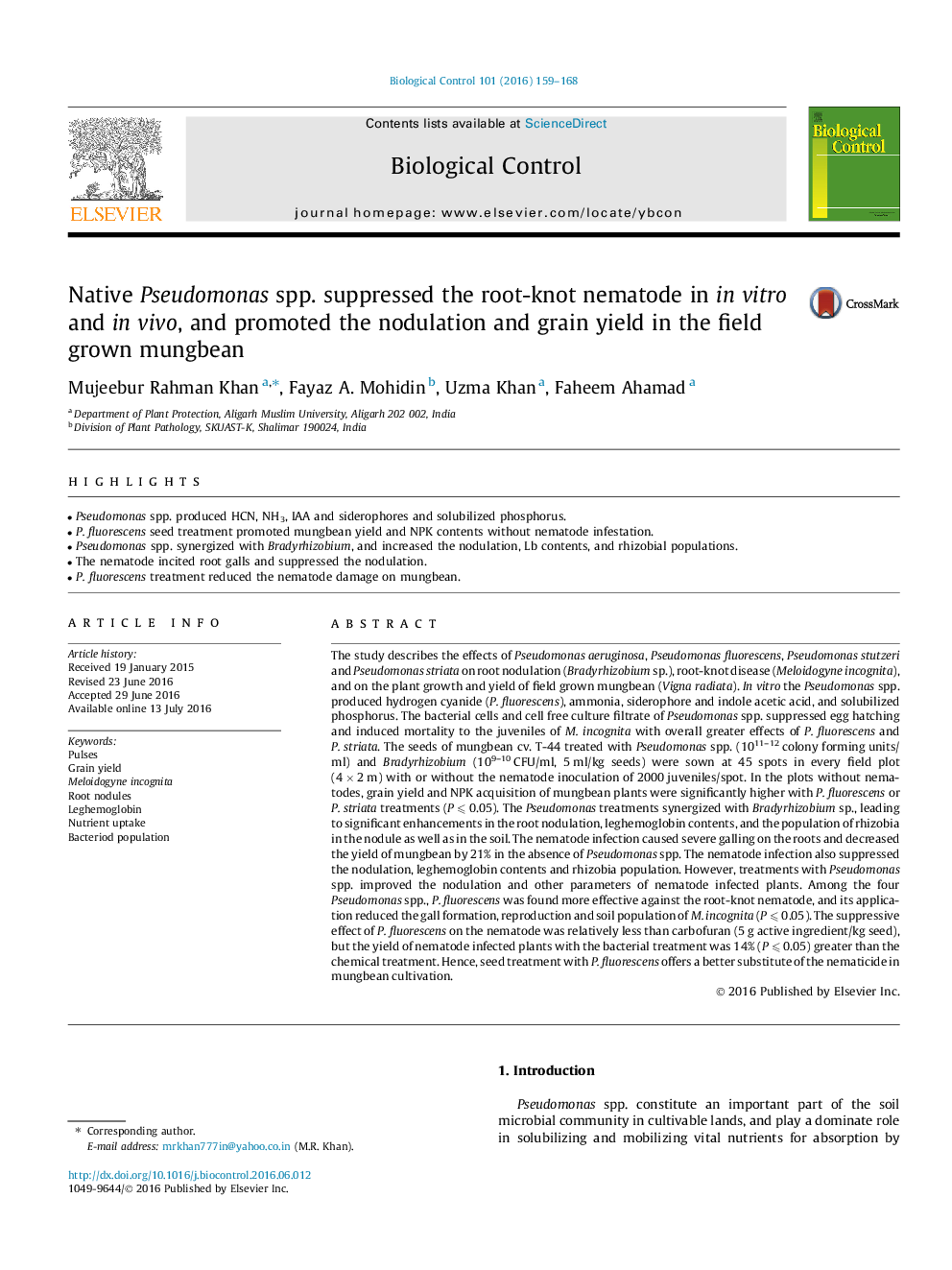| کد مقاله | کد نشریه | سال انتشار | مقاله انگلیسی | نسخه تمام متن |
|---|---|---|---|---|
| 4503617 | 1624233 | 2016 | 10 صفحه PDF | دانلود رایگان |

• Pseudomonas spp. produced HCN, NH3, IAA and siderophores and solubilized phosphorus.
• P. fluorescens seed treatment promoted mungbean yield and NPK contents without nematode infestation.
• Pseudomonas spp. synergized with Bradyrhizobium, and increased the nodulation, Lb contents, and rhizobial populations.
• The nematode incited root galls and suppressed the nodulation.
• P. fluorescens treatment reduced the nematode damage on mungbean.
The study describes the effects of Pseudomonas aeruginosa, Pseudomonas fluorescens, Pseudomonas stutzeri and Pseudomonas striata on root nodulation (Bradyrhizobium sp.), root-knot disease (Meloidogyne incognita), and on the plant growth and yield of field grown mungbean (Vigna radiata). In vitro the Pseudomonas spp. produced hydrogen cyanide (P. fluorescens), ammonia, siderophore and indole acetic acid, and solubilized phosphorus. The bacterial cells and cell free culture filtrate of Pseudomonas spp. suppressed egg hatching and induced mortality to the juveniles of M. incognita with overall greater effects of P. fluorescens and P. striata. The seeds of mungbean cv. T-44 treated with Pseudomonas spp. (1011–12 colony forming units/ml) and Bradyrhizobium (109–10 CFU/ml, 5 ml/kg seeds) were sown at 45 spots in every field plot (4 × 2 m) with or without the nematode inoculation of 2000 juveniles/spot. In the plots without nematodes, grain yield and NPK acquisition of mungbean plants were significantly higher with P. fluorescens or P. striata treatments (P ⩽ 0.05). The Pseudomonas treatments synergized with Bradyrhizobium sp., leading to significant enhancements in the root nodulation, leghemoglobin contents, and the population of rhizobia in the nodule as well as in the soil. The nematode infection caused severe galling on the roots and decreased the yield of mungbean by 21% in the absence of Pseudomonas spp. The nematode infection also suppressed the nodulation, leghemoglobin contents and rhizobia population. However, treatments with Pseudomonas spp. improved the nodulation and other parameters of nematode infected plants. Among the four Pseudomonas spp., P. fluorescens was found more effective against the root-knot nematode, and its application reduced the gall formation, reproduction and soil population of M. incognita (P ⩽ 0.05). The suppressive effect of P. fluorescens on the nematode was relatively less than carbofuran (5 g active ingredient/kg seed), but the yield of nematode infected plants with the bacterial treatment was 14% (P ⩽ 0.05) greater than the chemical treatment. Hence, seed treatment with P. fluorescens offers a better substitute of the nematicide in mungbean cultivation.
Journal: Biological Control - Volume 101, October 2016, Pages 159–168